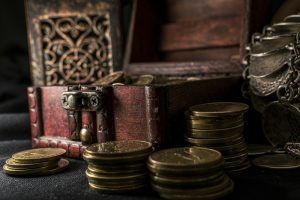Investing In Bitcoin: A Special Report – Part 1
Posted on — 4 CommentsHave you wondered if you should buy some bitcoin? If you answered yes to that question you are not alone. After all a massive media blitz has highlighted the cryptocurrency’s recent surge to a new all-time high above the $16,000 level.

Sounds like an investment you should be in on, right?
If you were lucky enough to purchase bitcoin at $1,000, congratulations!
While the tug of the “Fear of Missing Out” could be strong, remember the old Latin phrase: Caveat Emptor, which simply means “let the buyer beware” applies here. Let’s start with the basics.
What Is Bitcoin?
Bitcoin is a digital “virtual” currency developed in 2009 by the shadowy figure Satoshi Nakamoto. It is a global payment system that allows for anonymous peer-to-peer payments with no centralized authority. Bitcoin transactions take place via “blockchain technology” which is a so-called digital ledger where these transactions are publicly and chronologically recorded.
- Bitcoin is not a physical currency. It is not issued by any government and it is not legal tender.
People who use bitcoin confirm the validity of bitcoin using the publicly availably blockchain transactions on the open source digital ledger.
Where Does Bitcoin Come From?
So-called “miners” earn bitcoins who use their computers to confirm Bitcoin transactions. Every transaction is linked to other transactions to create blocks. These are linked to create the blockchain. This blockchain technology holds a record of every Bitcoin transaction that has ever taken place. As these computer operators verify transactions, they earn new Bitcoin, which is how new currency is “created.” The original computer program allows for 21 million Bitcoin to be generated.
What about Regular People?
People can buy bitcoin on exchanges, such as Coinbase and pay a fee to store Bitcoin in an online wallet.
11 Things to Consider Before You Buy Bitcoin
- What is the value of Bitcoin
People are focusing on the massive price increase, the record-setting “value.” But, what is actual the value of Bitcoin? There is none. People are buying Bitcoin on the “hope” that it will become widely accepted and widely used.
Recently, JPMorgan Chase & Co. Chief Executive Officer Jamie Dimon called bitcoin a “fraud” and he said he would fire any employee who was caught trading bitcoin for being “stupid.” However, he did admit that bitcoin was a good option for murderers and drug dealers.
2. Could Bitcoin be in a bubble phase?
People are buying it as part of a speculative buying binge. Remember the economic bubble in Dutch Tulip Bulb Mania?
In 1637, at the height of tulip mania some single tulip bulbs sold for more than 10 times the annual income of a skilled worker. Like all economic bubbles, it eventually popped. As tulip bulb prices dramatically collapsed over the course of a single week, many tulip bulb investors instantly went bankrupt.
“These bubbles tend to end in tears. And I worry about how this bubble might end,”
Billionaire hedge fund manager Ken Griffin said about bitcoin to CNBC on Nov. 27, 2017.
3. Security Risks: Any Bitcoin you might buy could simply disappear one day.
Bitcoin may be hacked. Operational glitches or malware could disrupt the peer-to-peer network. Cyberattacks can open the door to stolen private encryption keys.
This has already happened:
-
Hong-Kong based Bitfinex was hacked in August 2016. That resulted in the outright theft of $65 million in Bitcoin.
- In 2014, the Mt. Gox bitcoin exchange filed for bankruptcy and announced that 850,000 bitcoins had vanished into thin air. Simply gone.
The hackers: The bitcoin world is their world. They understand the shadowy worlds of the dark net better than anyone. If you think any bitcoin you might buy is “safe,” just remember how protected your Social Security number was by Equifax earlier this year where 145 million Americans had their most sensitive personal data stolen. Simply stolen. Bitcoin is a computerized technical system with who knows what vulnerabilities yet to be discovered.
Investors who are considering buying bitcoin need to understand the realities of what bitcoin is and isn’t. Take the time to learn the facts.
More reasons that you should be wary of Bitcoin in Part 2 of this Special Report.
Gold’s Future in a Technological World
Posted on — Leave a commentWe often consider gold demand to be a measure of how many people want to store their wealth in a resource that’s more durable than the dollar. In reality, however, far more factors drive the price. In recent decades technology has become one increasingly influential driver. As gold prices increase, the technology sector becomes more aggressive in their pursuit of substitute materials, which, in turn, puts downward pressure on gold.

Recently, The World Gold Council took an in-depth look at the relationship between technological development and demand for gold. In their report, they cited a dramatic rise in gold prices which quadrupled between 2005 and 2011. In response, the tech industry started to reevaluate hardware designs in an effort to stabilize their production costs. For example, electroplated coatings and gold bonding wire became thinner. At the same time, designers revisited ways to replace gold completely with alloys and substitution materials. As a result, gold, which had a 77% market share in the global bonding wire market, dropped to 40% where it stands today. The good news: this steep drop in demand from the tech sector may be leveling off, and, better still, there is reason to believe demand will increase.
By the end of Q3, this year gold posted year-to-date demand growth for the first time since 2010. The drop in demand has stopped because these substitutions, namely copper, are still inferior to gold and lack the anticorrosive and malleable properties of gold. Therefore, uncompromising industries like aeronautics will likely remain loyal to gold thereby setting a “floor” to diminishing demand.
The World Gold Council also cites a worldwide shortage of digital memory which should also buoy demand for gold. Just as gold demand diminishes among some technologies, it will likely grow in others. For example, new smartphone designs include new technologies like facial recognition, wireless charging, and infrared sensors. All of these features require new semiconductor designs which operate from gold bonding wire and other gold components.
Battery technology is likely to become more influential to gold demand in the coming decades. As electric vehicles hit the roads, gold will become a mainstay in the manufacturing process. Moreover, other car features will require more advanced technologies and in greater numbers. In-car entertainment systems, LEDs, printed circuit boards and braking systems are all examples electronics requiring gold.
Recent reports from the World Semiconductor Trade Statistics support this optimistic outlook. In a revised forecast they predicted a 21% increase in the global semiconductor market for 2017. Next year also looks strong as the WSTS reports, “For 2018, all major product categories and regions are forecasted to grow with the overall market up 7.0 percent, with Memory contributing the highest growth followed by Optoelectronics and Sensors.”
The key takeaway is that a gold purchase is more than just a store of wealth. It is an investment in the industry of technology. As zero-emission cars, virtual reality and telecommunications become an increasing part of our world gold will continue to play a vital role.
Three Rare Gold Coins That Write History
Posted on — Leave a commentRare coins always have a story to tell.

Pacific Octagonal Coin
In 1915 Congress decided to commemorate the Panama-Pacific International Exposition held in San Francisco. The legislation allowed for five unique coins to be minted, two of them were $50 pieces. One, particularly unusual in design, was octagonal. Quite a bit of effort went into minting the coins; professionals hauled a 14-ton press all the way from the Philadelphia mint to San Francisco. Interestingly, all the pieces sold poorly. As a result, many were returned for melting making them particularly rare today. Based on the quality, such a coin in today’s market could fetch anywhere from $33,000 to as much as $375,000. In fact, in one episode of Pawn Stars, the store owner, Rick, traveled to a major coin auction in Atlanta to find one of these rare pieces of history for a customer. Eventually, he tracked one down paying $67,500 for the coin. Shortly after, the customer bought it, as promised, for $70,000.
Queen Anne ‘Vigo’ Coin
One man in England re-discovered a gold coin he received as a child. Now 35, the man found the piece his father gave him, in a toy treasure chest. Apparently, no one in the family believed it carried much value. They were wrong. The coin is one of the rarest in all of Britain. It was a Queen Anne ‘Vigo’ gold piece valued at £250,000. It is one of only 20 minted. Of those twenty, five still remain unaccounted for. The coins were minted in the early 1700s. The gold used was part of the treasure the British took from a fleet that attempted, and failed, to take Cadiz, a Spanish city. As recently as 2013 another one of these coins claimed £300,000. The man believes the origin of the coin within his family dates back to his grandfather who traveled the world during his working years and made it a hobby to collect rare pieces.
The Wayfarthing Woman
Sometime a gold coin find is a historic event for more than one reason. This is the case with one man’s find in Norfolk, UK. A gold pendant and other coins, now belongs to a 23-year-old amateur metal detectorist. Moreover, some have claimed that the find is rewriting Anglo Saxon history as we know it. Experts suggest the find is worth £145,000. The pendant rested around a female skeleton’s neck buried in the soil. Originally, the piece was imported from Sri Lanka. The site also contained coins “bearing the marks of a continental king [which] is prompting a fundamental reassessment of the seats of power in Anglo Saxon England.” The value of the treasure suggests that the woman was of a particularly high status, perhaps even a member of the royal elite. One piece among the horde includes a golden cross which is now one of the earliest symbols of Christianity ever discovered. In an interview, the detectorist explained that he would likely use the proceeds for a payment on a home.
Millennials, Gold and a 335% Gain
Posted on — 1 CommentMillennials have a lot of people confused.

Countless articles offer advice for those presented with the scenario of engaging Millennials in the workplace. Moreover, major corporations like Mastercard are tripping over themselves to understand the mind of a Millennial. However, there’s one simple, overarching truth that everyone is missing; Millennials are people, and people like to feel secure. Before long we might begin to see Millennials seek security in their finances by embracing gold for its enduring characteristic as a safe haven asset.
Part of the value for Millennials who seek gold as an investment comes from their lengthy time horizon. With an extended period of growth, compounding can build returns over decades. Additionally, interest rates may also offer benefits to gold investors. The chief market strategist and head of research at the World Gold Council explained this phenomenon in an interview. He remarked that if global economies, “are unable to tolerate higher interest rates, then I suspect that interest rates won’t be going up for very long and that, I suspect, will be good for gold.” Of course, if interest rates rise those holding gold might see a deterioration in the value of their holdings. Even in this scenario of rising rates, however, there are reasons for Millennials to make gold part of their portfolio.
In the same interview, experts discussed the importance of considering the long-term. With so many decades of working years ahead, Millennials need to look beyond the hot equities market of today. That is, while stocks are rising fast now, there’s no reason to believe they will sustain this acceleration given outsized valuations. Gold, in contrast, is finite in its supply offering considerable upside potential for those disciplined enough to adopt a long-term strategy. Gold has returned an astounding 335% over the previous 30 years. Moreover, during a long enough period gold outpaces many other investments. For example, over a 45-year duration, history has shown that gold has outpaced both stocks and bonds.
Millennials, by definition, are young. They’re also plentiful; Millennials are the largest generation this country has ever seen, and they’re starting to save. Therefore, this generation should be considering how choices today will pan out over lengthy spans like 45 years. While many were young during the financial collapse of 2008/2009, they remember the tumultuous years and have resolved to evade the anguish of such financial burdens. Additionally, they remember the fraud and dishonesty of those who helped cause the mess. Gold does not require that the investor trust a CEO or a financial officer.
Gold helps ease fears arising from turbulent equity markets because the metal has a historically low correlation with stocks. Gold offers similar protections against inflation and currency devaluation. In the coming years, the financial world is bound to experience more change as new global conditions arise and new investment products emerge. Gold creates a stabilizing force over the long-term amid these inevitable shifts.
Millennials, like all other investors want stability and a strong rate of return. Gold provides both.
Three Reasons it’s Time to Take Your Portfolio off Cruise Control
Posted on — Leave a commentIf you are like many investors, your portfolio is on cruise control.

Maybe you have automatic paycheck deductions funneled toward your 401k. And, you chose your allocation and funds months or years ago and haven’t looked since. That’s normal. People are busy. Families, kids, weddings, jobs, sporting events, and even school plays.
Tending to your finances often falls to the wayside.
Here are 3 reasons why it’s time to add “Rebalancing Your Portfolio” to your to-do list this month
- Lock In Some Stock Market Profits
It’s not a profit until you actually exit the trade. Sure, the stock market is posting healthy gains in 2017, but those numbers you are staring at in your IRA or 401k account are just “paper gains.” Until you actually hit the button to sell out a portion of your stock position in a quarterly or yearly “rebalancing” effort, it is just a paper profit that could disappear fast in the next correction or bear market.
In a well-diversified portfolio, history suggests it is good to sell some of what has gone up and buy more of what has gone down in your portfolio from time to time. Stocks have gone up this year. If you intended to allocate 60% of your portfolio to stocks it could be at the 70% or even 75% level right now.
Now is a great time to lock in some of those paper profits.
- Rebalancing Helps You Manage Risk
It’s important for any investor to rebalance in order to manage risk. For example, in the current environment where the stock market has been strong it’s likely that an investor will have a larger allocation to stocks. This larger allocation brings with it more market exposure and may be riskier then that investor can tolerate or even wanted.
Rebalancing brings your portfolio back into alignment so you can sleep easy at night.
- Individual Investors Rarely Succeed In “Timing” The Market
Individual investors often fall into the trap of trying to time the stock market. It is easy to say “I’ll sell it at the top and then buy it at the bottom.” It has been shown time and again that trying to outsmart the collective wisdom of the millions of smart, well-informed people who trade in the market is very hard to do consistently no matter who you are.
Rebalancing also means that investors are buy low and sell high, which after all is the goal in investing. Without the discipline of rebalancing, many self-directed investors tend to buy high (when markets are hot and rising) and then sell low (when the market has tanked and they panic).
Disciplined rebalancing keeps you away from that market timing trap.
What is rebalancing?
Rebalancing simply means selling a portion your winners and not letting your portfolio get off track from your goals and objectives. Pick a regular time – either quarterly, twice a year or once a year and realign the portfolio for your pre-established risk-level.
How to rebalance
It’s simple and easy to do. Pull out your statements and take a look at your entire investment picture. Rebalancing simply involves selling a portion of your portfolio and using those proceeds to increase another investment. For example, in today’s climate, many investors are selling a portion of their stock exposure and transferring those proceeds into physical gold. That locks in their stock price gains in a vehicle that is proven to hold your wealth over time. You can even easily add physical gold to your IRA account.
Why precious metals?
Gold acts as an insurance policy, a hedge against equity market declines and a vehicle to protect and grow wealth. Blanchard and Company recommends that its clients allocate 10-15 percent of their investment portfolios to gold. Recent research has shown that portfolios with a 30% allocation to physical gold have shown better overall long-term performance. When the equities markets falter, gold performs strongly which is why diversification is important in the first place.
We can help
It may seem like a chore, but taking a few hours this weekend to shore up your portfolio may be one of the most important things you do this month. If you want some advice or help in the process, one of the Blanchard portfolio managers will be happy to walk you through the process. Give us a call today!
5 Surprising Facts about Black Friday
Posted on — Leave a commentShoppers are getting ready. Black Friday is just around the corner and retailers will be welcoming them with door busters and discounts before the Thanksgiving meal has even ended.

If you are planning to scoop up some deals this weekend, you aren’t alone. About 164 million Americans plan to shop during Thanksgiving weekend, according to National Retail Federation’s annual survey.
Every year shoppers look forward to discounts and retailers look forward to ringing cash registers. Here’s what’s new this year:
- More Americans will shop online than in brick and mortar stores in 2017.
Why fight for a parking spot at the mall? The convenience of “click and buy” online is the number one way holiday shoppers will buy gifts this year. For the first time ever in survey history, online is the most popular shopping destination in 2017 cited by 59 percent of consumers in the National Retail Federation.
- There is more time to shop this year.
Retailers are cheering because shoppers have an extra day to pile up the gifts in 2017. “Christmas falls 32 days after Thanksgiving this year, one day more than last year, and is on a Monday instead of Sunday, giving consumers an extra weekend day to complete their shopping,” the NRF said.
- Holiday season is more than 1/4 of annual U.S. Retail Sales.
Holiday shopping is huge. The holiday shopping season accounts for more than $1 Trillion (yes, with a T) in sales and over one quarter of total annual U.S. Retail Sales, according to the Deloitte 2017 Holiday survey.
- People spend…a lot.
In 2017, the average shopper will spend $1,226 this holiday season. For high income folks (or those earning over $100.000 that doubles to $2,226).
- Holiday shopping can be budget busting.
While this is the season of giving, it’s also the season of stretching budgets. NerdWallet’s 2017 Consumer Holiday Shopping report found that some Americans are still paying off holiday bills from 2016.
“Baby boomers were the most likely to accumulate debt (63%) among those who shopped during the 2016 holiday season, compared with 58% of Gen Xers and 40% of millennials. Of those who incurred holiday shopping debt in 2016, however, millennials and Gen Xers are more likely than baby boomers to still have it — nearly a quarter of millennials (24%) and 16% of Gen Xers have yet to pay theirs off, compared with just 8% of baby boomers,” the NerdWallet report said.
Key Takeaways
The holiday shopping season is a critical time for the nation’s retailers. Holiday shoppers have been conditioned to look for lower prices. Savvy online shoppers can easily look for the best deals there.
What’s On Your Shopping List?
Silver Coin Makes a Shiny Stocking Stuffer
As you make your lists and check them twice, consider the gift of something with true long-term value. A gift of gold or silver coins are something that will be treasured and can increase – potentially significantly – in value in the months and years ahead. Like cars, many material items bought for gifts decrease in value from the moment they leave the store. Not so with gold and silver coins, the long-term trend points higher for precious metals.
There might not be a better surprise in a stocking than a gift that is truly an investment. You can purchase a 1 ounce American Eagle silver coin for under $20. Deals don’t get any better than that.
Don’t Panic!
Posted on — Leave a commentPeople are getting scared. Forbes warns that “China’s Economy Will Overtake The U.S. In 2018.” Meanwhile, others are issuing equally dire warnings. Fortune stated that “China Says It Will Lead the World Economy.” For more than a decade major news publications have proclaimed that China’s rise to dominance is inevitable. In fact, the threat of China absorbing American jobs was a central issue our last presidential campaign.

These concerns, however, ignore a key point that should lay many of theses anxieties to rest: we live in an increasingly globalized world. The rise of one could easily mean the rise of another. Why? “China dreads the wrath of an alienated Western middle class,” remarked The Atlantic. As major trading partners, the U.S. and China share more goals than most understand.
Why does this matter to gold investors?
Recently, the World Gold Council reported that gold “ETF inflows slowed sharply from the spectacular 2016 levels.” As we’ve explored earlier, gold ETFs, don’t offer some of the most cherished characteristics of physical gold. However, this downward movement in the ETF world can have ramifications for even those holding physical gold. Bad news right?
Wrong.
As ETF flows near a halt, bar and coin investment is up. Who is responsible for this restorative effect? China. In the third quarter, gold bar and coin demand spiked 17% year-over-year, and China was the largest contributor to this growth with demand up 57%. Moreover, China has experienced the second highest volume of demand for bar and coin investment on record. This news should delight anyone holding gold no matter where they live.
China’s renewed interest in gold comes amid two developments in the country. First, many fear an eventual devaluation of the yuan coupled with rising inflation. When concerns surrounding currency pervade a country gold often becomes a hot commodity. Second, while some new investment opportunities are opening to Chinese citizens, there are still relatively few to choose from. This scarcity of options is compounded by recent moves to restrict real estate investment in the country.
The ordinary investor living in the U.S. may have little regard for these sweeping trends in China. But, as the economy continues to globalize, “the butterfly effect” is becoming less of an abstract concept and more of an economic truism. Of course, the global economy is more complicated than the network of transactions linking the U.S. and China.
Consider, for example, that recent gold prices are supported by a 36% increase in bar and coin demand in Europe compared to the third quarter last year with Germany as a key driver of the total demand. The rise of economies in other countries does not necessitate peril in the U.S. As these increases to bar and coin demand abroad have shown, U.S. investors can benefit from the success of others when the asset is a globally accepted currency.
A Lifetime of Collecting Coins and the $30 Million Payoff
Posted on — Leave a commentPeople start collecting coins for many different reasons.

It was John Jay Pittman’s grandmother who first infused in him the sense of wonder and history captured within each coin that she gave to him.
Make no mistakes, John Pittman was not brought up with a silver spoon. He was born in North Carolina in 1913, the oldest of 7 children. His father worked at the railroad.
John Pittman was a man of humble roots and ordinary means throughout his life. Yet, he assembled, over a lifetime, a collection that ultimately sold for over $30 million after his death.
Due to his acumen, his love for the history behind the coins, and willingness to buy when the opportunity presented itself, his family and loved ones left behind will never have to worry about money for their entire lives.
The Amazing Story of Pittman’s Legendary Coins
Pittman worked his way through college and then moved to Rochester New York in 1936 to work for Eastman Kodak. A career man, he worked there for almost his entire life. He was happily married for over 50 years to Gehring, a math teacher in the public school system.
How did he amass a collection worth $30 million?
The answer is simple. On a limited budget, throughout his life, John Pittman pursued his passion for numismatics.
He consistently purchased, when he could, U.S. gold and silver coins. He chose the rarest coins that he could afford on his salary.
History is what drove him to search out and purchase whatever rare coins that he could on his limited budget. He wasn’t after the money or a fortune.
In the mid-1950’s, John was chasing some special coins. The hunt led him and Gehring all the way to an auction in Egypt. John took out a second mortgage on his house to pay for the trip. In the end it paid off.
One of the coins he purchased in Cairo was an 1833 $5 gold piece for $605. Later, that same coin sold for an incredible $467,500.
He was not a wealthy man, yet he assembled a collection worth over $30 million in his lifetime. Estimates are that his total investment was a mere $75,000.
If John Pittman, a man of humble beginnings can do it, anyone can. Here are tips to help you along your journey. You may be surprised at what you can build in a short amount of time.
3 Tips to Assemble the Coin Collection of a Lifetime
- Have patience and seek out quality. Talk to trusted advisors and well-respected coin dealers. If you have a certain coin that you are searching for, let your portfolio manager at Blanchard know. We have deep connections within the numismatic world and may be able to assist.
- Be complete. Build collections that include “sets.” Be persistent and complete your sets. Often collections with sets have more value than the individual coins on their own.
- Follow your passions. Is there a certain period in history that fascinates you? Learning more about that time can enrich your ownership of a specific coin.
Four Gold Hordes We’re Still Trying to Find
Posted on — Leave a commentFew things fire up the imagination like lost treasure, buried away just waiting to be found. We take a look at four gold hordes that people continue to look for to this day.
The 1715 Spanish Treasure Fleet
A fleet of twelve Spanish ships was en route to Spain from the New World when a catastrophic hurricane hit. Only one ship survived. The other eleven sank off the eastern coast of Florida. Each carried immense wealth. However, one, in particular, carried the motherload. The San Miguel is considered by many to be one of the most valuable treasure galleons ever lost. To this day, treasures from this ship and others from the fleet wash up on Florida beaches. In September of 2013, one lucky family found $300,000 worth of gold less than 200 yards offshore. The total value of the San Miguel and other ships is well into the hundreds of millions and people continue to search the seas for the fortune.
Fenn’s Folly
Nothing changes one’s perspective like a terminal diagnosis. In 1988, art dealer Forrest Fenn learned that he had cancer. Doctors told him he had less than two years to live. This ticking clock inspired him to bury $1 million of his wealth. He encouraged treasure hunters to find the horde and even provided cryptic clues. He wrote a poem with confusing lines like, “Begin it where warm waters halt And take it in the canyon down, Not far, but too far to walk.” Though the idea came to him after his diagnosis, he buried the treasure twenty years later after beating the illness. No one has found the stash though Fenn claims some seekers have come as close as 200 feet to the site. Fortune hunters be warned: two people have died searching for Fenn’s legacy.
Victorio Peak
Some gold hunters believe the Southern Rocky Mountains of New Mexico are hiding millions in god buried within a collapsed mine shaft. The story begins with Milton Ernest “Doc” Noss. He was on a deer hunting trip when he made the find. Liberating the treasure proved difficult. There was only one way out of the mine, and the opening was too narrow to effectively remove the gold. Foolishly, the “Doc” decided to use dynamite to blast a larger opening. This attempt, unsurprisingly, collapsed the entrance sealing the riches away. Doc Noss lived only a few years more; an associate shot him amid a dispute. Thought the Noss family continued to press for access the US government stepped in taking control of the area for use as a nuclear testing site. Officials claim they never found Noss’s alleged gold. To this day we don’t know who is telling the truth.
Schultz’s Shuffle
The life of a crime boss is hard. Dutch Shultz was a New York Mobster living large in the 1920s and 1930s. He made a fortune bootlegging and conducting organized crime. It wasn’t long, however, before the tax man came knocking. Eventually, he was indicted by a Grand Jury. He arranged for a professional to build a special watertight safe in which he stashed $7 million to keep away from other mobsters and the Federal Government. He hid it in the Catskill Mountains with the intention to retrieve it later in life. Schultz was eventually shot and killed. Many believe his fortune remains buried. Find it, and it’s yours.
Gold During the Changing of the Guards
Posted on — Leave a commentWith a relatively new president in office many have cited the uncertainty of our times with regard to investing. However, this notion that a US president can single-highhandedly control the economic landscape of the country is misguided. In truth, policy changes from Federal Reserve hold much more sway over the state of our markets. Now is an especially good time to revisit this fact as Janet Yellen, the current Chair of the Federal Reserve prepares to step down. Jerome Powell will soon be taking over prompting many to question how this new leadership will influence our economy.

Many consider Powell to be a continuation of Yellen’s policies. “A Powell Fed might look a lot like it has since Mr. Greenspan retired in 2006,” remarked The Wall Street Journal. Though many are comfortable with Powell as a successor this changing of the guards has become a reminder of how administration changes can wield influence. A clearer, though less discussed, example is the news that William Dudley, the leader of the Federal Reserve Bank of New York, announced that he’ll be stepping down early than expected. This move has led some to speculate on “the uncertainty over whether the central bank will be more hawkish with its rate increases moving forward depending on who fills the open positions.”
Why does this matter for gold investors? Unexpected events like this help stabilize gold prices by effectively creating a “floor” even in times of falling value.
Gold prices have fallen in recent weeks hitting multi-month lows. This comes at a time when gradual increases in rates has reinvigorated investors’ appetites for yield-bearing investments. However, uncertainties in other areas, like the Federal Reserve Bank of New York, keeps investors vigilant. This cautiousness helps prevent further slips in gold prices.
On a global scale, instability in Spain’s government and Venezuela’s economy are also fueling the fire. Investors can get a concise, holistic measure of uncertainty around the world with the Economic Policy Uncertainty Index. This single number represents a reading based on two components. The first quantifies uncertainty within newspaper coverage of economic policies. The second gauges how many federal tax code provisions will expire in the coming years. A reading of this figure from January 1, 1997 to October 1, 2017, shows a clear upward trend reaching an all-time high in January of this year. Until October of 2008 the figure had never risen above 200. Since then the index has broken the 200 mark on six occasions.
This is a visual illustration of the pervading uncertainty that makes gold a worthwhile, long-term investment. While many eager investors get caught up in the moment, the long-term is what counts. Recent events, which are pushing gold down, are fleeting. However, the supportive elements that prevent a complete collapse of gold prices are consistent because they’re based in the inherent uncertainty of an increasingly complex world.
The key for success remains the same; investors must maintain perspective on the wider picture while ignoring the headlines that pray on passing fears.









